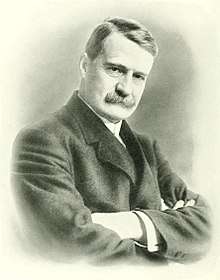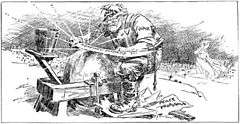Luther D. Bradley
Luther Daniels Bradley (September 29, 1853 – January 9, 1917) was an American illustrator and political cartoonist associated with the Chicago Daily News. Born in New Haven, Connecticut, he graduated from Yale in 1875. After some years at his father's business, he traveled abroad, and spent over a decade in Melbourne, Australia, drawing for such publications as Melbourne Punch. He returned to Chicago in 1893, working for the Daily Journal and Inter Ocean, before joining the Daily News in 1899, where he spent the remainder of his life and career. He was known for strong anti-war sentiments, opposing U.S. involvement in World War I.[1][2][3][4]
Luther D. Bradley | |
|---|---|
 | |
| Born | September 29, 1853 |
| Died | January 9, 1917 (aged 63) |
| Nationality | American |
| Alma mater | Yale |
| Employer |
|
| Known for | Editorial cartooning |
| Signature | |
 | |
Life
Bradley was born in New Haven, Connecticut, to Francis and Sarah Beaman (Ruggles) Bradley. In 1857 the Bradley family moved to Chicago and later to nearby Evanston, where Bradley attended public school. He attended Northwestern University from 1870 to 1873 and Yale College from 1873 to 1875, where he took part in crew.[1] After graduation he worked at his father's Chicago real estate business, Baird & Bradley.[5] In 1882 he embarked upon a world trip, and after visiting London, arrived in Melbourne, where he took an illustrating job with the satirical magazine Australian Tit-Bits; later incorporated into Melbourne Life with Bradley as editor and cartoonist. In 1888 he became chief cartoonist of the Melbourne Punch after the retirement of artist Tom Carrington, and was at the Punch until 1893, with notable coverage of the Australian labor movement.[4] He popularized Carrington's "King Working Man" figure, a crowned giant representing organized labor.[6][7] His cartoons were generally accepted in London as fair presentations of Australian opinions.[8]
His father having fallen ill, Bradley returned to Chicago in 1893. He successively worked for the Chicago Daily Journal (1894) and Inter Ocean (1894–1898), and in 1899 published the children's books Our Indians and Wonderful Willie!. In 1899 he joined the Chicago Daily News, where he became art director. His cartoons often appeared on the front page.[9] It was during World War I that his work became most widely known.[8] He was known among cartoonists as the most prominent critic of American interventionism,[10] by 1916 being the only cartoonist of a major daily paper to oppose U.S. military involvement.[11] Cartoon historian Richard Marschall notes Bradley was not the only antiwar cartoonist, but was "perhaps the most eloquent in illustrating his arguments."[9]
He married Agnes Floyd Smith in Evanston on October 31, 1901, and had four children: Francis, John Freeman, Sarah Elizabeth, and Margaret.[5] In religion he was Episcopalian and in politics an Independent Republican.[12] He died at his home in Wilmette, Illinois, on January 9, 1917. Two days later, a tribute cartoon penned by John T. McCutcheon appeared on the front page of the Chicago Daily Tribune.[13] Cartoons by Bradley, a collection of his work along with tributes from Daily News associates, was published in March 1917.[4] Three months after his death, America entered World War I. In subsequent decades, Bradley's life and cartoons were discussed in numerous scholarly works.[14][15][11] In 1980, Richard Marschall wrote "[Bradley's] own cartoon messages deserve to be reintroduced to America."[9] A drawing of Bradley's adorned the cover of Karen Russell's acclaimed 2011 novel Swamplandia!.[16]
Works
Books
- Our Indians, a Midnight Visit to the Great Somewhere-or-other. New York: E. P. Dutton & Co. 1899.
- Wonderful Willie! What he and Tommy did to Spain. New York: E. P. Dutton & Co. 1899.
- War Cartoons from the Chicago Daily News. Chicago: Chicago Daily News. 1914.
- Cartoons by Bradley, Cartoonist of the Chicago Daily News. Chicago: Rand McNally. 1917.
Select cartoons
 "More!" (Punch, 1890): 'King Working Man', representing Australian labor unions, demands a worker's 'honest earnings'
"More!" (Punch, 1890): 'King Working Man', representing Australian labor unions, demands a worker's 'honest earnings' Scene from Wonderful Willie! (1899)
Scene from Wonderful Willie! (1899).jpg) "Design for a Union Station" (1907), depicting railroad tycoon E. H. Harriman swallowing American railroads
"Design for a Union Station" (1907), depicting railroad tycoon E. H. Harriman swallowing American railroads.jpg) "The Harvest Moon" (1914), depicting dead soldiers strewn across a barren landscape
"The Harvest Moon" (1914), depicting dead soldiers strewn across a barren landscape "The Final Answer?" (January 4, 1917), Bradley's last cartoon, depicting War sharpening a sword labeled "renewed efforts" while stomping on a paper labeled "peace proposals"
"The Final Answer?" (January 4, 1917), Bradley's last cartoon, depicting War sharpening a sword labeled "renewed efforts" while stomping on a paper labeled "peace proposals"
References
- "A Great American Cartoonist of the War Gone". The Literary Digest. Vol. 54 no. 7. February 17, 1917. pp. 402–403.
- "Bradley of the Chicago Daily News". Cartoons Magazine. Vol. 7. 1915. p. 638.
- Borgens, Helen (1984). "Luther Daniels Bradley: Guide to the Great Somewhere-or-Other". In Darling, Harold; Neumeyer, Peter (eds.). Image and Maker: An Annual Dedicated to the Consideration of Book Illustration. La Jolla, California: Green Tiger Press. pp. 26–36. ISBN 0881380113.
- Mahood, Marguerite (1979). "Bradley, Luther (1853–1917)". Australian Dictionary of Biography. 7. Melbourne University Press. ISSN 1833-7538. Retrieved 26 February 2017 – via National Centre of Biography, Australian National University.
- Smith, Henry J. (1917). . . Chicago: Rand McNally – via Wikisource.
- "Luther D. Bradley". Punch. Melbourne. March 22, 1917. p. 4.
- Mahood, Marguerite (October 1969). "Melbourne Punch and its Early Artists". The LaTrobe Journal (4): 65–81 – via State Library of Victoria.
- "Funeral rites of L. D. Bradley to be held today". Chicago Tribune. January 11, 1917. p. 9.
- Marschall, Richard (1980). "Bradley, Luther Daniels (1853–1917)". In Horn, Maurice (ed.). The World Encyclopedia of Cartoons. New York: Chelsea House. p. 136. ISBN 0-87754-088-8.
- Dewey, Donald (2008). The Art of Ill Will: The Story of American Political Cartoons. NYU Press. p. 47. ISBN 978-0-8147-2015-8.
- Lamb, Chris (2004). Drawn to Extremes: The Use and Abuse of Editorial Cartoons. Columbia University Press. pp. 82–84. ISBN 978-0-231-13066-0.
- "Bradley, Luther Daniels". The Book of Chicagoans: A Biographical Dictionary of Leading Living Men of the City of Chicago. A.N. Marquis. 1911. p. 81.
- "Bradley of the Daily News". Chicago Daily Tribune. January 11, 1917. p. 1.
- Moore, William (1934). The Story of Australian Art: From the Earliest Known Art of the Continent to the Art of To-day. Angus & Robertson Ltd. p. 107.
- Miller, Worth Robert (2011). Populist Cartoons: An Illustrated History of the Third-party Movement in the 1890s. Truman State University Press. pp. 157, 164. ISBN 978-1-61248-010-7.
- Maslin, Janet (16 February 2011). "In Florida Slough With the Gators and Family Ghosts. Karen Russell's Swamplandia! - Review". The New York Times.
External links


- Works by Luther D. Bradley at the Library of Congress
- The Ohio State University Billy Ireland Cartoon Library & Museum Art Database